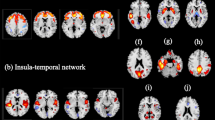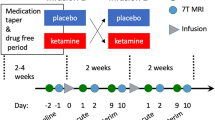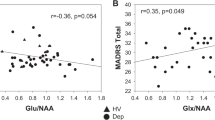Abstract
While an excess of glucocorticoids is associated with hippocampal pathology in mood disorders, lithium exerts robust neuroprotective and neurotrophic effects. Here, 21 stably remitted bipolar I patients who had been on chronic lithium maintenance therapy, on average, for more than a decade, and 19 carefully matched healthy controls were studied using 3 T 1H-magnetic resonance spectroscopy of left and right hippocampus. Salivary cortisol samples were obtained to assess activity of the hypothalamus–pituitary–adrenal system. Absolute concentrations of N-acetylaspartate (NAA), choline-containing compounds and total creatine were similar in euthymic bipolar patients and healthy controls. Hippocampal glutamate concentrations were significantly increased as an effect of patient status (patients>controls) and laterality (left hippocampus>right hippocampus). Hippocampal glutamate content (Glu) was strongly correlated with NAA. Across groups and within the patient group, diurnal saliva cortisol levels showed a significant inverse relationship with both Glu and NAA. Taken together, these results add to the concept of bipolar disorder as an illness involving disturbed hippocampal structural plasticity under the opposing influences of lithium and glucocorticoids.
This is a preview of subscription content, access via your institution
Access options
Subscribe to this journal
Receive 12 print issues and online access
$259.00 per year
only $21.58 per issue
Buy this article
- Purchase on Springer Link
- Instant access to full article PDF
Prices may be subject to local taxes which are calculated during checkout



Similar content being viewed by others
References
Kessler RC, Chiu WT, Demler O, Merikangas KR, Walters E . Prevalence, severity, and comorbidity of twelve-month DSM-IV disorders in the National Comorbidity Survey Replication (NCS-R). Arch Gen Psychiatry 2005; 62: 617–627.
Osby U, Brandt L, Correia N, Ekbom A, Sparen P . Excess mortality in bipolar and unipolar disorder in Sweden. Arch Gen Psychiatry 2001; 58: 844–850.
Colla M, Kronenberg G, Deuschle M, Meichel K, Hagen T, Bohrer M et al. Hippocampal volume reduction and HPA-system activity in major depression. J Psychiatry Res 2006; 41: 553–560.
Manji HK, Drevets WC, Charney DS . The cellular neurobiology of depression. Nat Med 2001; 7: 541–547.
Sheline YI, Sanghavi M, Mintun MA, Gado MH . Depression duration but not age predicts hippocampal volume loss in medically healthy women with recurrent major depression. J Neurosci 1999; 19: 5034–5043.
Benes FM, Kwok EW, Vincent SL, Todtenkopf MS . A reduction of nonpyramidal cells in sector CA2 of schizophrenics and manic depressives. Biol Psychiatry 1998; 44: 88–97.
Brauch RA, Adnan El-Masri M, Parker Jr JC, El-Mallakh RS . Glial cell number and neuron/glial cell ratios in postmortem brains of bipolar individuals. J Affect Disord 2006; 91: 87–90.
Knable MB, Barci BM, Webster MJ, Meador-Woodruff J, Torrey EF . Molecular abnormalities of the hippocampus in severe psychiatric illness: postmortem findings from the Stanley Neuropathology Consortium. Mol Psychiatry 2004; 9: 609–620.
Liu L, Schulz SC, Lee S, Reutiman TJ, Fatemi S . Hippocampal CA1 pyramidal cell size is reduced in bipolar disorder. Cell Mol Neurobiol 2007; 27: 351–358.
Swayze II VW, Andreasen NC, Alliger RJ, Yuh WT, Ehrhardt JC . Subcortical and temporal structures in affective disorder and schizophrenia: a magnetic resonance imaging study. Biol Psychiatry 1992; 31: 221–240.
Bauer M, London ED, Rasgon N, Berman SM, Frye MA, Altshuler LL et al. Supraphysiological doses of levothyroxine alter regional cerebral metabolism and improve mood in bipolar disorder. Mol Psychiatry 2005; 10: 456–469.
Atmaca M, Yildirim H, Ozdemir H, Poyraz AK, Tezcan E, Ogur E . Hippocampal (1)H MRS in first episode bipolar I patients. Prog Neuropsychopharmacol Biol Psychiatry 2006; 30: 1235–1239.
Bertolino A, Frye M, Callicott JH, Mattay VS, Rakow R, Shelton-Repella J et al. Neuronal pathology in the hippocampal area of patients with bipolar disorder: a study with proton magnetic resonance spectroscopic imaging. Biol Psychiatry 2003; 53: 906–913.
Deicken R, Pegues MP, Anzalone S, Feiwell R, Soher B . Lower concentrations of hippocampal N-acetylaspartate in familial bipolar I disorder. Am J Psychiatry 2003; 160: 873–882.
Mueller-Oerlinghausen B, Berghofer A, Bauer M . Bipolar disorder. Lancet 2002; 359: 241–247.
Schou M . Forty years of lithium treatment. Arch Gen Psychiatry 1997; 54: 9–13.
Chen G, Zeng WZ, Yuan PX, Huang LD, Jiang YM, Zhao ZH et al. The mood-stabilizing agents lithium and valproate robustly increase the levels of the neuroprotective protein bcl-2 in the CNS. J Neurochem 1999; 72: 879–882.
Xu J, Culman J, Blume A, Brecht S, Gohlke P . Chronic treatment with a low dose of lithium protects the brain against ischemic injury by reducing apoptotic death. Stroke 2003; 34: 1287–1292.
Hellweg R, Lang UE, Nagel M, Baumgartner A . Subchronic treatment with lithium increases nerve growth factor content in distinct brain regions of adult rats. Mol Psychiatry 2002; 7: 604–608.
Chen G, Rajkowska G, Du F, Seraji-Bozorgzad N, Manji HK . Enhancement of hippocampal neurogenesis by lithium. J Neurochem 2000; 75: 1729–1734.
Moore GJ, Bebchuk JM, Hasanat K, Chen G, Seraji-Bozorgzad N, Wilds IB et al. Lithium increases in N-acetyl-aspartate in the human brain: in vivo evidence in support of bcl-2's neurotrophic effects? Biol Psychiatry 2000; 48: 1–8.
Moore GJ, Bebchuk JM, Wilds IB, Chen G, Manji HK . Lithium-induced increase in human brain grey matter. Lancet 2000; 356: 1241–1242.
Yucel K, Taylor VH, McKinnon MC, Macdonald K, Alda M, Young LT et al. Bilateral hippocampal volume increase in patients with bipolar disorder and short-term lithium treatment. Neuropsychopharmacology 2007; 33: 361–367.
Du J, Gray NA, Falke CA, Chen W, Yuan P, Szabo ST et al. Modulation of synaptic plasticity by antimanic agents: the role of AMPA glutamate receptor subunit 1 synaptic expression. J Neurosci 2004; 24: 6578–6589.
Zarate CA, Quiros JA, Singh JB, Denicoff KD, De Jesus G, Luckenbaugh DA et al. An open-label trial of the glutamate-modulating agent riluzole in combination with lithium for the treatment of bipolar depression. Biol Psychiatry 2006; 57: 430–432.
Yildiz-Yesiloglu A, Ankerst DP . Neurochemical alterations of the brain in bipolar disorder and their implications for pathophysiology: a systematic review of the in vivo proton magnetic resonance spectroscopy findings. Prog Neuropsychopharmacol Biol Psychiatry 2006; 30: 969–995.
Hashimoto K, Sawa A, Iyo M . Increased levels of glutamate in brain from patients with mood disorders. Biol Psychiatry 2007; 62: 1310–1316, Epub ahead of print.
Dowlatshahi D, MacQueen GM, Wang JF, Reiach JS, Young LT . G protein-coupled cyclic AMP signaling in postmortem brain of subjects with mood disorders: effects of diagnosis, suicide, and treatment at the time of death. J Neurochem 1999; 73: 1121–1126.
Daban C, Vieta E, Mackin P, Young AH . Hypothalamic–pituitary–adrenal axis and bipolar disorder. Psychiatr Clin North Am 2005; 28: 469–480.
Schmider J, Lammers CH, Gotthardt U, Dettling M, Holsboer F, Heuser IJ . Combined dexamethasone/corticotropin-releasing hormone test in acute and remitted manic patients, in acute depression, and in normal controls: I. Biol Psychiatry 1995; 38: 797–802.
Karst H, Berger S, Turiault M, Tronche F, Schutz G, Joels M . Mineralocorticoid receptors are indispensable for nongenomic modulation of hippocampal glutamate transmission by corticosterone. Proc Natl Acad Sci USA 2005; 102: 19204–19207.
Lowy MT, Wittenberg L, Yamamoto BK . Effect of acute stress on hippocampal glutamate levels and spectrin proteolysis in young and aged rats. J Neurochem 1995; 65: 268–274.
Magarinos AM, McEwen BS . Stress-induced atrophy of apical dendrites of hippocampal CA3c neurons: involvement of glucocorticoid secretion and excitatory amino acid receptors. Neuroscience 1995; 69: 89–98.
Magarinos AM, McEwen BS, Flugge G, Fuchs E . Chronic psychosocial stress causes apical dendritic atrophy of hippocampal CA3 pyramidal neurons in subordinate tree shrews. J Neurosci 1996; 16: 3534–3540.
Wood GE, Young LT, Reagan LP, Chen B, McEwen BS . Stress-induced structural remodeling in hippocampus: prevention by lithium treatment. Proc Natl Acad Sci USA 2004; 101: 3973–3978.
Dixon JF, Hokin LE . Lithium acutely inhibits and chronically up-regulates and stabilizes glutamate uptake by presynaptic nerve endings in mouse cerebral cortex. Proc Natl Acad Sci USA 1998; 95: 8363–8368.
Shao L, Young LT, Wang JF . Chronic treatment with mood stabilizers lithium and valproate prevents excitotoxicity by inhibiting oxidative stress in rat cerebral cortical cells. Biol Psychiatry 2005; 58: 879–884.
Gould E, McEwen BS, Tanapat P, Galea LA, Fuchs E . Neurogenesis in the dentate gyrus of the adult tree shrew is regulated by psychosocial stress and NMDA receptor activation. J Neurosci 1997; 17: 2492–2498.
Czeh B, Welt T, Fischer AK, Ehrhardt A, Schmitt W, Muller MB et al. Chronic psychosocial stress and concomitant repetitive transcranial magnetic stimulation: effects on stress hormone levels and adult hippocampal neurogenesis. Biol Psychiatry 2002; 52: 1057–1065.
Schubert F, Gallinat J, Seifert F, Rinneberg H . Glutamate concentrations in human brain using single voxel proton magnetic resonance spectroscopy at 3 Tesla. NeuroImage 2004; 21: 1762–1771.
Gallinat J, Kunz D, Senkowski D, Kienast T, Seifert F, Schubert F et al. Hippocampal glutamate concentration predicts cerebral theta oscillations during cognitive processing. Psychopharmacology 2006; 187: 103–111.
Wittchen H, Zaudig M, Frydrich T . Strukturiertes Klinisches Interview für DSM-IV (SKID-I und SKID-II) Achse I: Psychische Störungen/Achse II: Persönlichkeitsstörungen. Hogrefe Verlag:Göttingen, Germany, 1997.
Weber-Hamann B, Werner M, Hentschel F, Bindeballe N, Lederbogen F, Deuschle M, et al., Metabolic changes in elderly patients with major depression: evidence for increased accumulation of visceral fat at follow-up. Psychoneuroendocrinology 2006; 31: 347–354.
Weber-Hamann B, Kopf D, Lederbogen F, Gilles M, Heuser I, Colla M et al. Activity of the hypothalamus–pituitary–adrenal system and oral glucose tolerance in depressed patients. Neuroendocrinology 2005; 81: 200–204.
Schubert F, Seifert F, Elster C, Link A, Walzel M, Rinneberg H . Improvement of the analytical quality of MR spectroscopy data by frequency corrected averaging. Magn Reson Mat Physiol Biol Med 2000; 11 (Suppl. 1): 189.
Elster C, Link A, Schubert F, Seifert F, Walzel M, Rinneberg H . Quantitative MRS: comparison of time domain and time domain frequency domain methods using a novel test procedure. Magn Reson Imaging 2000; 18: 597–606.
Elster C, Schubert F, Link A, Walzel M, Seifert F, Rinneberg H . Quantitative magnetic resonance spectroscopy: semi-parametric modeling and determination of uncertainties. Magn Reson Med 2005; 53: 1288–1296.
Mlynarik V, Gruber S, Moser E . Proton T (1) and T (2) relaxation times of human brain metabolites at 3 Tesla. NMR Biomed 2001; 14: 325–331.
Ashburner J, Friston K . Multimodal image coregistration and partitioning—a unified framework. Neuroimage 1997; 6: 209–217.
Ellison DW, Beal MF, Martin JB . Amino acid neurotransmitters in postmortem human brain analyzed by high performance liquid chromatography with electrochemical detection. J Neurosci Methods 1987; 19: 305–315.
Sasaki H, Muramoto O, Kanazawa I, Arai H, Kosaka K, Iizuka R . Regional distribution of amino acid transmitters in postmortem brains of presenile and senile dementia of Alzheimer type. Ann Neurol 1986; 19: 263–269.
Frye MA, Watzl J, Banakar S, O’Neill J, Mintz J, Davanzo P et al. Increased anterior cingulate/medial prefrontal cortical glutamate and creatine in bipolar depression. Neuropsychopharmacology 2007 e-pub ahead of print.
Blasi G, Bertolino A, Brudaglio F, Sciota D, Altamura M, Antonucci N et al. Hippocampal neurochemical pathology in patients at first episode of affective psychosis: a proton magnetic resonance spectroscopic imaging study. Psychiatry Res 2004; 131: 95–105.
Bachmann RF, Schloesser RJ, Gould TD, Manji HK . Mood stabilizers target cellular plasticity and resilience cascades: implications for the development of novel therapeutics. Mol Neurobiol 2005; 32: 173–202.
Manji HK, Moore GJ, Chen G . Lithium at 50: have the neuroprotective effects of this unique cation been overlooked? Biol Psychiatry 1999; 46: 929–940.
Petroff OAC, Errante LD, Rothman DL, Kim JH, Spencer DD . Neuronal and glial metabolite content of the epileptogenic human hippocampus. Ann Neurol 2002; 52: 635–642.
Moreno A, Ross BD, Bluml S . Direct determination of the N-acetyl-L-aspartate synthesis rate in the human brain by (13)C MRS and [1-(13)C]glucose infusion. J Neurochem 2001; 77: 347–350.
Clark JF, Doepke A, Filosa JA, Wardle RL, Lu A, Meeker TJ et al. N-acetylaspartate as a reservoir for glutamate. Med Hypotheses 2006; 67: 506–512.
Dager SR, Friedman SD, Parow A, Demopulos C, Stoll AL, Lyoo IK et al. Brain metabolic alterations in medication-free patients with bipolar disorder. Arch Gen Psychiatry 2004; 61: 450–458.
Castillo M, Kwock L, Courvoisie H, Hooper SR, Proton MR . Proton MR spectroscopy in children with bipolar affective disorder: preliminary observations. AJNR Am J Neuroradiol 2000; 21: 832–838.
Michael N, Erfurth A, Ohrmann P, Gossling M, Arolt V, Heindel W et al. Acute mania is accompanied by elevated glutamate/glutamine levels within the left dorsolateral prefrontal cortex. Psychopharmacology (Berl) 2003; 168: 344–346.
Cecil KM, DelBello MP, Morey R, Strakowski SM . Frontal lobe differences in bipolar disorder as determined by proton MR spectroscopy. Bipolar Disord 2002; 4: 357–365.
Chang K, Adleman N, Dienes K, Barnea-Goraly N, Reiss A, Ketter T . Decreased N-acetylaspartate in children with familial bipolar disorder. Biol Psychiatry 2003; 53: 1059–1065.
Kunnecke B, Cerdan S, Seelig J . Cerebral metabolism of [1,2-13C2]glucose and [U-13C4]3-hydroxybutyrate in rat brain as detected by 13C NMR spectroscopy. NMR Biomed 1993; 6: 264–277.
Chapa F, Kunnecke B, Calvo R, Escobar del Rey F, Morreale de Escobar G, Cerdan S . Adult-onset hypothyroidism and the cerebral metabolism of (1,2-13C2) acetate as detected by 13C nuclear magnetic resonance. Endocrinology 1995; 136: 296–305.
Cruz F, Cerdan S . Quantitative 13C NMR studies of metabolic compartmentation in the adult mammalian brain. NMR Biomed 1999; 12: 451–462.
Chapa F, Cruz F, Garcia-Martin ML, Garcia-Espinosa MA, Cerdan S . Metabolism of (1-(13)C) glucose and (2-(13)C, 2-(2)H(3)) acetate in the neuronal and glial compartments of the adult rat brain as detected by [(13)C, (2)H] NMR spectroscopy. Neurochem Int 2000; 37: 217–228.
Fonnum F . Glutamate: a neurotransmitter in mammalian brain. J Neurochem 1984; 42: 1–11.
Hamberger A, Nystrom B . Extra- and intracellular amino acids in the hippocampus during development of hepatic encephalopathy. Neurochem Res 1984; 9: 1181–1192.
Luborzewski A, Schubert F, Seifert F, Danker-Hopfe H, Brakemeier E, Schlattmann P et al. Metabolic alterations in the dorsolateral prefrontal cortex after treatment with high-frequency repetitive transcranial magnetic stimulation in patients with unipolar major depression. J Psychiatry Res 2006; 41: 606–615.
O’Donnell T, Rotzinger S, Ulrich M, Hanstock CC, Nakashima TT, Silverstone PH . Effects of chronic lithium and sodium valproate on concentrations of brain amino acids. Eur Neuropsychopharmacol 2003; 13: 220–227.
Antonelli T, Ferioli V, Lo Gallo G, Tomasini MC, Fernandez M, O′Connor WT et al. Differential effects of acute and short-term lithium administration on dialysate glutamate and GABA levels in the frontal cortex of the conscious rat. Synapse 2000; 38: 355–362.
McQuade R, Young AH . Future therapeutic targets in mood disorders: the glucocorticoid receptor. Br J Psychiatry 2000; 177: 390–395.
Matsubara T, Funato H, Kobayashi A, Nobumoto M, Watanabe Y . Reduced glucocorticoid receptor alpha expression in mood disorder patients and first-degree relatives. Biol Psychiatry 2006; 59: 689–695.
Spiliotaki M, Salpeas V, Malitas P, Alevizos V, Moutsatsou P . Altered glucocorticoid receptor signaling cascade in lymphocytes of bipolar disorder patients. Psychoneuroendocrinology 2006; 31: 748–760.
Kempermann G . Regulation of adult hippocampal neurogenesis—implications for novel theories of major depression. Bipolar Disord 2002; 4: 17–33.
Sapolsky RM . Glucocorticoids and hippocampal atrophy in neuropsychiatric disorders. Arch Gen Psychiatry 2000; 57: 925–935.
McEwen BS . Glucocorticoids, depression, and mood disorders: structural remodeling in the brain. Metabolism 2005; 54 (5 Suppl 1): 20–23.
Brown ES, Woolston DJ, Frol A, Bobadilla L, Khan DA, Hanczyc M et al. Hippocampal volume, spectroscopy, cognition, and mood in patients receiving corticosteroid therapy. Biol Psychiatry 2004; 55: 538–545.
Ridder S, Chourbaji S, Hellweg R, Urani A, Zacher C, Schmid W et al. Mice with genetically altered glucocorticoid receptor expression show altered sensitivity for stress-induced depressive reactions. J Neurosci 2005; 25: 6243–6250.
Chourbaji S, Gass P . Glucocorticoid receptor transgenic mice as models for depression. Brain Res Rev 2007; e-pub ahead of print.
Acknowledgements
We thank Rainer Hellweg and Dietrich von Calker for helpful comments on the article. We also thank Herbert Rinneberg for valuable technical support. This study was supported in part by a grant from the Bundesministerium für Bildung und Forschung (Kompetenznetz Depression to IH).
Author information
Authors and Affiliations
Corresponding author
Rights and permissions
About this article
Cite this article
Colla, M., Schubert, F., Bubner, M. et al. Glutamate as a spectroscopic marker of hippocampal structural plasticity is elevated in long-term euthymic bipolar patients on chronic lithium therapy and correlates inversely with diurnal cortisol. Mol Psychiatry 14, 696–704 (2009). https://doi.org/10.1038/mp.2008.26
Received:
Revised:
Accepted:
Published:
Issue Date:
DOI: https://doi.org/10.1038/mp.2008.26
Keywords
This article is cited by
-
ACC Glu/GABA ratio is decreased in euthymic bipolar disorder I patients: possible in vivo neurometabolite explanation for mood stabilization
European Archives of Psychiatry and Clinical Neuroscience (2021)
-
Diagnosis and body mass index effects on hippocampal volumes and neurochemistry in bipolar disorder
Translational Psychiatry (2017)
-
Bcl-2 rs956572 Polymorphism is Associated with Increased Anterior Cingulate Cortical Glutamate in Euthymic Bipolar I Disorder
Neuropsychopharmacology (2013)
-
Distinct neurometabolic profiles are evident in the anterior cingulate of young people with major psychiatric disorders
Translational Psychiatry (2012)
-
Neurobiological trait abnormalities in bipolar disorder
Molecular Psychiatry (2009)



